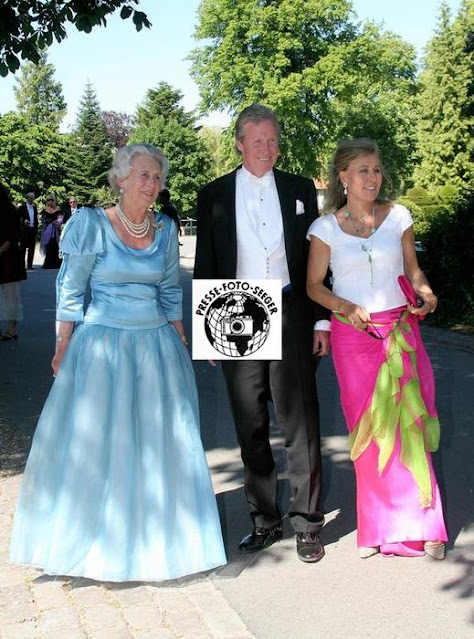 |
| Prince Philip and Princess Danica unveil a statue of Queen Marie. Photo (c) Prince Philip of Serbia. |
Monday, November 8, 2021
Serbian Royals Inaugurate Monument to Queen Marie of Yugoslavia
Sunday, November 7, 2021
Grand Duchess Maria Pavlovna of Russia's Jewels at Auction in Geneva
 |
| The jewels with an imperial provenance. Photo (c) Sotheby's. |
On 10 November, a brooch and a pair of ear clips that belonged to Grand Duchess Maria Pavlovna of Russia will be sold at auction by Sotheby's in Geneva. Born Duchess Marie of Mecklenberg-Schwerin, Marie married Grand Duke Vladimir Alexandrovich of Russia, a son of Emperor Alexander II of Russia. The jewels are estimated to sell for anywhere between $300,000 and $520,000. Given their history, it would not be surprising if they fetch much more.
Sotheby's offers the following description of this fascinating lot:
From a European Princely Family, Formerly from a European Imperial Family
Historically Important sapphire and diamond brooch and a pair ear clips
circa 1900
Comprising : a brooch of plaque design, set at the centre with an oval sapphire weighing 26.80 carats, the border set with cushion-shaped and rose diamonds, maker's marks for Sophia Schwan, probably for Bolin, St Petersburg, 1899-1908 and Russian assay marks, the pair of ear clips en suite, set with step-cut sapphires weighing 6.69 and 9.36 carats respectively, within a border of rose-cut and cushion-shaped diamonds, to a later fitted case by Cartier stamped with the crown of the Royal House of Greece, King of the Hellenes.
The auction house also notes that this set of a brooch and ear clips was firstly owned by Grand Duchess Maria Pavlovna of Russia, who then left them to her only daughter Grand Duchess Elena Vladimirovna (Princess Nicholas of Greece). The catalogue entry for this lot gives further insight into how these jewels with a Russian imperial heritage were retrieved from Russia following the Revolution:
A ROMANOV INHERITANCEAs is made clear by the provenance provided by Sotheby's, these particular items were inherited by Grand Duchess Elena Vladimirovna of Russia, who married Prince Nicholas of Greece. Nicholas and Elena had three daughters: Princess Olga (married Prince Paul of Yugoslavia), Princess Elisabeth (married Count Carl Theodor zu Toerring-Jettenbach), and Princess Marina (married Prince George, Duke of Kent). Therefore, it is possible that these jewels are being sold by one of Elena's descendants. No doubt, this gorgeous sapphire brooch and accompanying ear clips will make an historic addition to anyone's collection.
From the Collection of HIH Grand Duchess Maria Pavlovna
Two shabby Gladstone bags were chosen by Albert Stopford to secretly collect Maria Pavlovna's jewels from the closed but as yet unpillaged Vladimir Palace in St Petersburg. The jewels were stored in a safe in her Moorish style suite of rooms. Access was obtained with the cooperation of Maria Pavlovna's eldest son Boris [author's note: Kirill was Maria's eldest son] and trusted servant who let in Stopford, dressed in workman clothes, through a side door. He carefully dismantled the jewels, folding the pieces into old newspaper to protect them. In the safe was also money which Stopford changed into new Revolutionary notes andd the on 30th July set out for a train journey of three nights to Kislovodsk in Caucasus where Maria Pavlovna had a house. In his diary he records his arrival: “KISLOVODSK. The grand Duchess received me in her cabinet de travail and we counted the money which I had bought her in my boots form Petrograd. It was in revolutionary thousand rouble notes, which she had never seen before.” This was the last visit he made to see her before setting out for London with her jewels though he did receive a letter form her telling him “ that the night before - September 13-14 - the the Committee of Workmen and Soldiers came to the house at 2.30 am and stayed until 6, opening, searching and turning everything topsy-turvy”. The pressure was ever increasing. This dramatic story is graphically retold in William Clarke’s recent book “Hidden Treasures of the Romanovs, saving the Royal jewels”.
Albert Henry Stopford, who was at the time, aged fifty five and so not eligible for war service, was very much part of the social scene in St Petersburg (then called Petrograd). He was a witness from the Revolution from July 1915 to October 1917 and published his diary and letters anonymously in 1919. From these it is clear that he was on very familiar terms with Grand Duchess Vladimir, seeing her almost every day when both in Petrograd. He was also in constant touch with the British Ambassador and the embassy staff passing back information and acting as a semi official courier on his journeys between Petrograd and London.
Grand Duchess Vladimir must have trusted him implicitly to put her extraordinary collection of jewels into his care. He had an advantage because on his journeys to and from England as the English Foreign Office and the War Office as well as the French and the Russian Embassies, used him to carry confidential papers which they feared might be in intercepted in the mail. Trustworthy travelers were a rarity so they took advantage of his travel for direct communication. It these circumstances he was effectively carrying their Diplomatic bags as he said “as a matter of courtesy and not in an official capacity”. He made full use of this privileged position and in those years he made four visits to England which he recalls in his diary. For instance on 22nd October 1916 he had “No bother with customs”. On another occasion the border officials wanted to examine his bags but he insisted he was carrying official papers and eventually they climbed down, no search was made and he was allowed to proceed on his journey.
During the war the safest way from Petrograd to England or France was by train first north through Finland, which at that time was in Russian hands, and so into Sweden and then on to either Bergen or Arendal in Norway. As German U-boats patrolled the North Sea and the coastal water were mined, the voyage from southern Sweden to Newcastle or Scotland was chosen as the shortest and safest journey for the steamer. The reality of these dangers is recalled in Stopford’s diary of 14th January 1916 “Not too bad a crossing. As we neared Arendal, in Norway we nearly ran into a mine. The sudden veering of the steamer threw us all off our seats. All along the south coast of Norway, where there are many currents, loose mines are constantly being washed up.” Later the same year on the way back from Petrograd he recalls in his diary for Thursday August 10th 1916 in rather telegraphic style, “before leaving the fjords for the open sea, was sent for by the captain. He expected the steamer to be stopped by German submarines, and said the F.O. bags ought to be weighted. The ships carpenter put iron into the coulisses of the bags and deposited them on the deck handy to be thrown overboard. Ship stopped suddenly in the night. Rushed on deck and found only a sea-frog. Arrived at Newcastle-on-Typne.”
Stopford left Petrograd on 26th September 1917 carrying Maria Pavlovna’s fabulous collection of jewels including the sensational sapphire brooch and earrings in this sale to embark on what must have been a very anxious ten day journey. Behind him the Provisional Government of Alexander Kerensky tottering and ahead lay the prospect of the hazardous journey across the North Sea which by this stage in the war was heavily mined. As it turned out he was able to follow his usual route via Finland and Sweden without encountering any difficulties, finally arriving safely by boat at Aberdeen on 6th October and professed himself “delighted to see policemen again”.
Meanwhile in the Caucasus the situation became so bad that Maria Pavlovna put her affairs in order and made arrangements for the cigarette boxes and cufflinks in the Vladimir Palace to be taken to Swedish Legation in Petrograd (these quite remarkably have only recently been discovered, safe and sound, in the Swedish Foreign Office in Stockholm and are now to be sold at Sotheby’s in London on 30thNovember 2009). She also made her own plans to leave Russia. The only route open to her was to make her way from Caucasus to the White Russian stronghold at the Black Sea port of Novorossiysk, a journey of 800 kilometers through a war-torn country. Despite the deteriorating situation and the fact that it was late autumn it is reported that she set off in style for the fifty mile journey to the nearest railway situation in an open carriage with her maid of honor at her side.
The next first hand report of Grand Duchess Vladimir’s escape from Russia is by her niece Grand Duchess Olga Alexandrovna who also left her departure to the last minute. She was already at the Black Sea port of Novorossiysk which at the time was the principle center of Denekin’s White Army and waiting for a passage when she heard at her Aunt Michen, the formidable Grand Duchess Vladimir, had arrived after a harrowing escape from Caucasus. She is quoted in her biography as recalling “I went to see her. I was duchess. There had never been much love between Aunt Michen and my own family, but I felt proud of her. Disregarding peril and hardship, the stubbornly had kept all the trimmings of bygone splendor and glory. And somehow carried it off. When even generals found themselves lucky to find a horse-cart and an old nag to bring them into safety, Aunt Michen made a long journey in her own train. It was battered all right – but it was hers. For the first time in my life I found it was a pleasure to kiss her”.
Even though the situation was very dangerous and time short it is said that the Grand Duchess, acting very much in character, is said to have refused passage on a ship which required a change ta Istanbul as she could have had to submit to the ignominy of being deloused. Instead, she obtained a later passage in February 1920 and within a month of her departure Novorossiysk fell to the Bolsheviks. Her passage was on an Italian vessel and it is recorded at once again “the good Stopford received us in Venice with money to pay for our passage”. From there she went to Switzerland and then to Paris.
On his return to England Albert Stopford put the jewels in a safety deposit box in a bank in London where they remained for rather more then two years by which time Maria Pavlovna had reached Europe. They then had discussions about who would provide the best professional advice. Cartier in Paris seemed to be the best choice as many of the jewels had come from them and they had offered to make no charge for the valuation. In mid-June 1920, Stopford received what was probably his last letter form “his Grand Duchess” where she said that “the offer is very tempting” but sadly in July her health had been severely affected by the ordeal of the previous four years and on 6th September she died. Her tomb is in the Russian Orthodox church Contrexeville in north eastern France which she had had build in memory of her husband in 1909.
The division of jewels therefore became the main matter for her will and the were placed in the hands of Cartier for valuation. Thereafter the division was by no means simple.
Source: Historically important sapphire and diamond brooch and a pair ear clips, circa 1900
Thursday, November 4, 2021
100 Years Since the Birth of Princess Fawzia of Egypt, Eventual Queen of Iran
 |
| Queen Fawzia of Iran, Princess of Egypt. |
 |
| Queen Fawzia of Iran in 1942, photographed by Cecil Beaton. |
 |
| The Queen of Iran. |
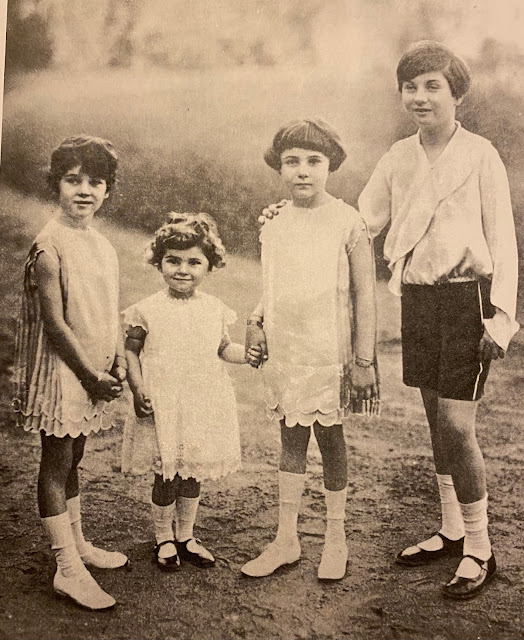 |
| Left to right: Princess Faiza, Princess Faika, Princess Fawzia, and Prince Farouk. |
 |
| A young princess. |
 |
Princess Fawzia of Egypt and Crown Prince Mohamed Reza of Iran. Abdin Palace, Cairo. |
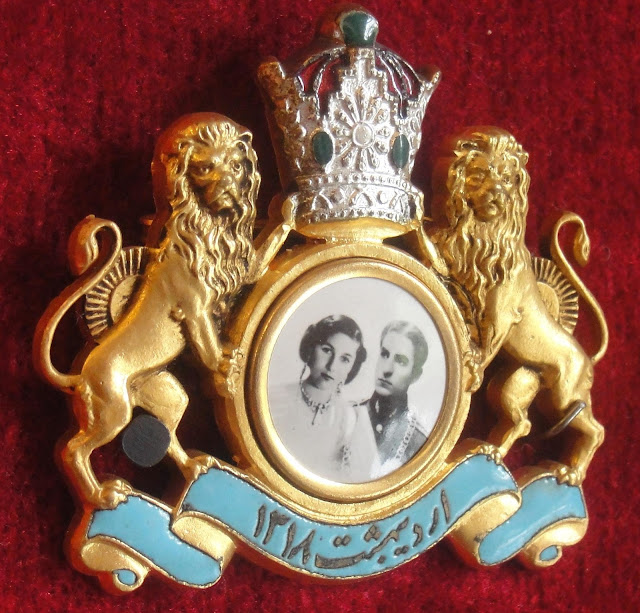 |
| A commemorative medallion issued to celebrate the union of the Iranian heir and the Egyptian princess. |
 |
| The newlyweds. |
 |
| Left to right: Princess Shams of Iran, Princess Ashraf of Iran, the Duke of Aosta, Queen Nazli of Egypt with her daughter Princess Fawzia, the Countess of Athlone. |
 |
| Front row, left to right: Princess Ashraf of Iran, Queen Tadj ol-Molouk of Iran, Princess Fawzia, and Princess Shams. |
 |
| Crown Prince Mohammed Reza and Crown Princess Fawzia with their daughter Princess Shahnaz. |
 |
| The Shah and Queen of Iran with their daughter in Tehran. Photographed by Cecil Beaton in the mid-1940s. |
 |
| Queen Fawzia of Iran and her daughter Princess Shahnaz. |
 |
| Ismail Chirine and Princess Fawzia, 1949. |
 |
| Ismail Chirine and Princess Fawzia with their daughter Nadia and their son Hussein. |
 |
| Princess Shahnaz Pahlavi and her mother Princess Fawzia of Egypt in the 1970s. |
 |
| Princess Fawzia with her only son, Hussein Chirine. |
Adieu to a Doyenne of the Gotha: Duchess Marie-Alix of Schleswig-Holstein (1923-2021)
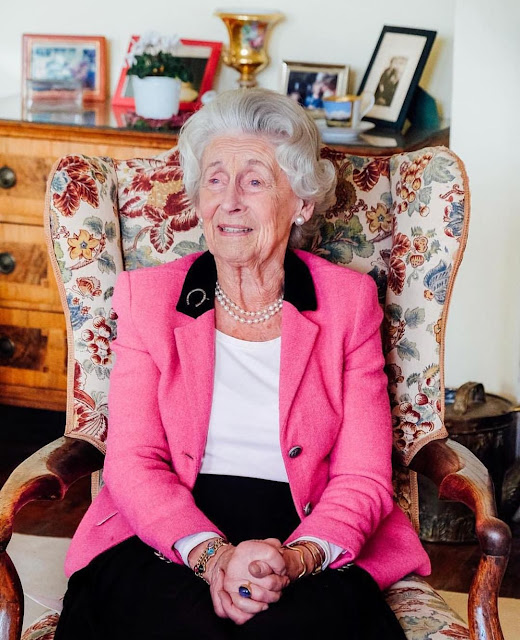 |
| Duchess Marie-Alix of Schleswig-Holstein on the occasion of her 95th birthday. Photo courtesy of Fürst Alexander zu Schaumburg-Lippe / Stiftung Louisenlund. |
On Monday, 1 November 2021, Dowager Duchess Marie-Alix of Schleswig-Holstein died peacefully at her home of Gut Bienebek in Holstein. She was ninety-eight years-old. The four children of the duchess were by her side when she died in her sleep; after her passing, the family released a brief statement: "In deep sorrow and full of love we say goodbye to our mother, grandmother and great-grandmother and look back on her eventful and fulfilled life with respect and immense gratitude."
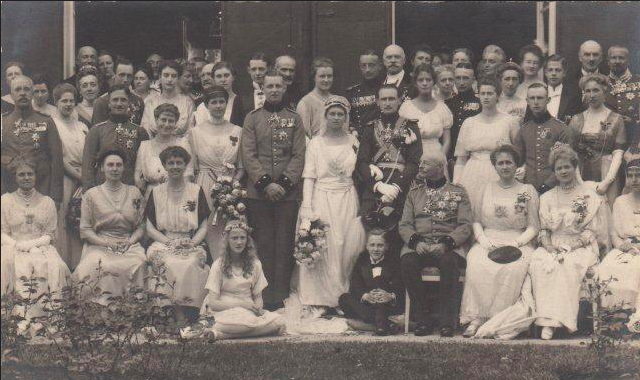 |
| The wedding of Prince Stephan zu Schaumburg-Lippe and Duchess Ingeborg of Oldenburg, 1921. |
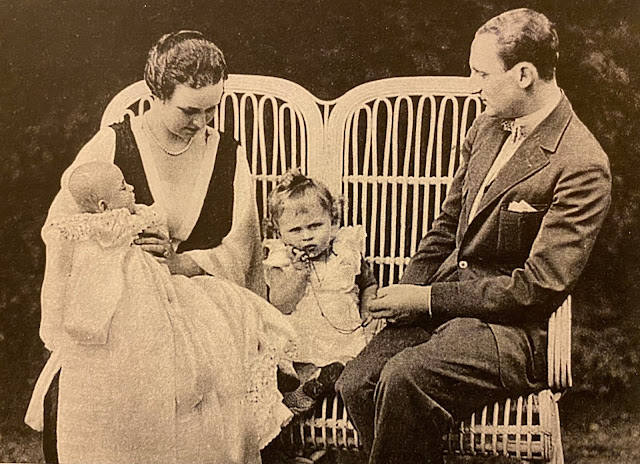 |
| Prince Stephan and Princess Ingeborg with Princess Marie-Alix and infant Prince Georg-Moritz. Photo (c) David McIntosh. |
 |
| Fürst Georg zu Schaumburg-Lippe. |
 |
| Fürstin Marie zu Schaumburg-Lippe. |
 |
| Grand Duke Friedrich August II of Oldenburg. |
 |
| Grand Duchess Elisabeth of Oldenburg. |
The paternal grandparents of Marie-Alix were Fürst Georg of Schaumburg-Lippe (1846-1911) and his wife Princess Marie of Saxe-Altenburg (1864-1918). Her maternal grandparents were Grand Duke Friedrich August II of Oldenburg (1851-1932) and his second wife Duchess Elisabeth of Mecklenburg-Schwerin (1869-1955). Marie-Alix was a first cousin of Duke Anton-Günther of Oldenburg, Fürstin Eilika of Leiningen, Fürst Wittekind of Waldeck and Pyrmont, Fürstin Guda of Wied, and Fürst Philipp-Ernst of Schaumburg-Lippe.
 |
| Duke Peter of Schleswig-Holstein. Photo (c) David McIntosh. |
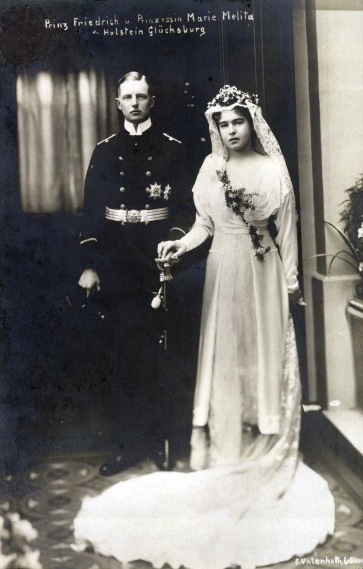 |
| Prince Friedrich Ferdinand zu Schaumburg-Lippe and Princess Marie Melita zu Hohenlohe-Langenburg on their wedding day. |
 |
| Left to right: Duke Friedrich Ferdinand, Prince Peter, and Princess Marie-Alix. Photo (c) David McIntosh. |
 |
| Left to right: Princess Marita, Prince Alexander, Duke Christoph, and Princess Ingeborg. Photo (c) David McIntosh. |
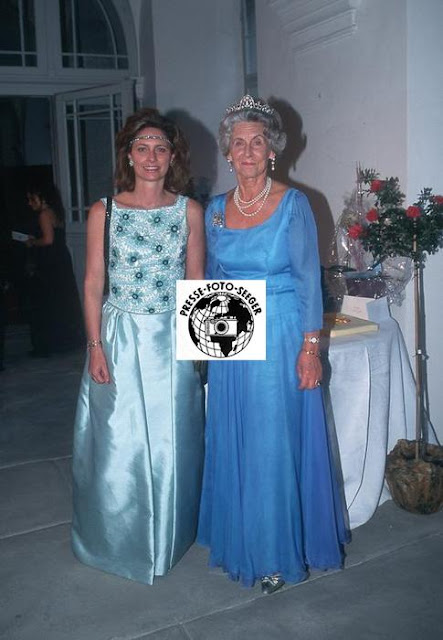 |
| Princess Barbara with her mother-in-law Duchess Marie-Alix at the wedding of Hereditary Prince Bernhard of Baden, 2001. Photo (c) Seeger-Presse. |
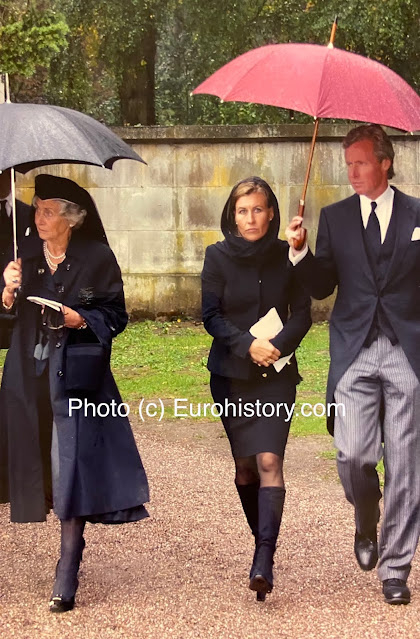 |
| Duchess Marie-Alix together with her son Duke Christoph and daughter-in-law Duchess Elisabeth attend the funeral of Fürst Philipp-Ernst zu Schaumburg-Lippe, 2003. |
 |
| Birthday cheers! Duchess Marie-Alix celebrates her 95th birthday surrounded by students of Louisenlund while her daughter Princess Ingeborg happily looks at her much loved mother. Photo (c) Stiftung Louisenlund. |
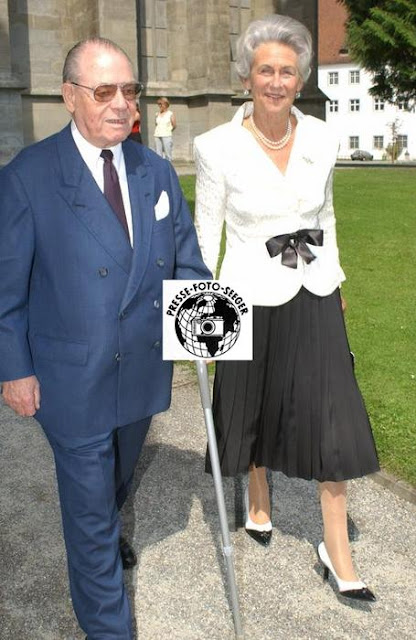 |
| Fürst Friedrich Wilhelm of Hohenzollern and Duchess Marie-Alix at the wedding of Hereditary Prince Bernhard of Baden, 2001. |
 |
| Duchess Marie-Alix with her children Princess Ingeborg and Duke Christoph attend the memorial service for Fürst Kraft zu Hohenlohe-Langenburg, 2004. |
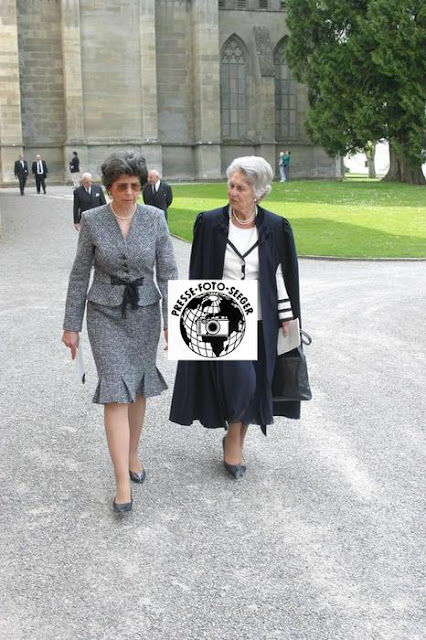 |
| Princess Marianne of Baden and Duchess Marie-Alix attend the funeral of Prince Georg Wilhelm of Hannover, 2006. Photo (c) Seeger-Presse. |
Wednesday, November 3, 2021
Brazilian Royals Celebrate Union of Prince Pedro Alberto and Princess Alessandra
 |
| Prince Pedro Alberto and Princess Alessandra at the altar. Photo (c) Princess Maria Gabriela of Orleans and Bragança. |
 |
| Prince Antonio, Princess Maria Gabriela, and Princess Christine. Photo (c) Pro Monarquia. |
 |
| Prince Rafael, Prince Antonio, two unidentified gentleman (likely Princes of Orleans and Braganza), and Hereditary Prince Henri de Ligne. Photo (c) Pro Monarquia. |
 |
| Prince Imperial Bertrand of Brazil and Prince Michel de Ligne in the centre. Photo (c) Pro Monarquia. |
Our best wishes to Prince Pedro Alberto and Princess Alessandra!
Sunday, October 31, 2021
The Tragic Tale of a Forgotten American Princess: Lois Radziwill
 |
| Lois Evans Olson Radziwill. |
Over the centuries, many American women have married into European royal and noble families. One of the most unknown is Princess Lois Radziwill. Everyone knows of Caroline Lee Bouvier, who married Prince Stanislaw Radziwill in 1959. Understandably, very few are aware of Lois, who married Stanislaw's first cousin once removed in 1950.
 |
| The birth certificate of Lois Lorine Evans. |
 |
| Irvin and Hazel Evans with their daughter Lois, 1928. |
On 10 February 1928 at Minot, North Dakota, Lois Lorine (later changed to "Lorraine") Evans was born as the first child of Endre Irvin Evans (1900-1966) and his wife Hazel Viola Hills (1903-1995). Lois Evans had four younger siblings: Joyce Arlene Evans (1929-1995), Irvin Howard Evans (1932-2003), Marilyn Jean Evans (1936-1991), and Yvonne Lee Evans (1944-2011). Lois Evan's paternal grandparents were born in Norway: Edward Gilbert Evensen (1866-1938) and Inga Marie Iversdatter Sollid (1871-1949). Her maternal grandparents were Adrian Bloomer Hills (1879-1965) and Rena Susan Muir (1880-1959).
 |
| Lois Evans photographed in a bridal veil around the time of her marriage to sailor George Olson, 1945. Photo (c) The Bismarck Tribune. |
Lois was raised in Bismarck, ND. Her father worked as a foreman at a crematorium. Lois began her high school studies in Bismarck, but she moved west and graduated in 1945 from high school in Santa Monica, California. In 1944, her parents had relocated to California. Aged eighteen, Lois Evans married George Conrad Olson, a member of the US Navy and the son of Mr. and Mrs. Horace Olson of Minnesota, on 1 December 1945 in Salt Lake City, Utah. The marriage was of short duration; however, it is uncertain as to when or if it was terminated legally. A girlfriend of Lois, Mrs. Beatrice Johnson Betts, who was an attendant at Lois' wedding to George Conrad, was not certain as to the particulars surrounding the end of the Olson/Evans marriage. Reportedly, Lois moved to New York and worked as a model before going to Paris to study fashion design.
 |
| Princess Lois Radziwill on holiday in Rome, July 1950. |
While in France, Lois met Prince Wladislaw Jerzy Gogislaw Radziwill (1881-1963) at a dinner party in December 1949 at Cannes. The prince was the only child of Prince Karol Radziwill (1839-1907) and Princess Teresa Lubomirska (1857-1883). His great-grandparents were Prince Antoni Radziwill (1775-1833) and Princess Luise of Prussia (1770-1836).
 |
| Prince Wladislaw and Princess Lois Radziwill. |
 |
| Lois Radizill. Photo (c) Ebbs Breuer. |
The Rudy Wedding Anniversary of the Duke and Duchess of Buccleuch and Queensberry
 |
| The Duke and Duchess. |
Today, the Duke and Duchess of Buccleuch and Queensberry celebrate their fortieth wedding anniversary.
 |
| Richard and Elizabeth with their three eldest children, 1993. Photo (c) Alamy. |
On 31 October 1981, Richard Montagu-Douglas-Scott, then Earl of Dalkeith, married Lady Elizabeth Kerr. The groom was the eldest child and son of the Duke and Duchess of Buccleuch and Queensberry. The bride was the daughter of the Marquess and Marchioness of Lothian. Richard and Elizabeth have four children: Lady Louise (b.1982; married Rupert Trotter); Walter, Earl of Dalkeith (b.1984; married Elizabeth Cobbe); Lord Charles (b.1987); and Lady Amabel (b.1992). After the death of his father John in 2007, Richard succeeded as 10th Duke of Buccleuch and 12th Duke of Queensberry.
Our congratulations to the Duke and Duchess on their Ruby Wedding Anniversary!
Featured Post
The Plantagenet Family Tree: The Intriguing History of England's Plantagenet Dynasty Kings
The Plantagenet Family Tree: A Royal History The Plantagenet family was one of the most powerful royal dynasties in European history, rul...
Popular Posts
-
William, Viscount Stormont. Photograph (c) Robert Ormerod. Charlotte Clune. Photograph from LinkedIn. On 20 February ...
-
Embed from Getty Images The Norwegian press is reporting that self-proclaimed Shaman Durek Verrett, the partner of Princess Märtha L...
-
View this post on Instagram In the midst of COVID, a piece of $h!t president, and the power and poignancy of the...

